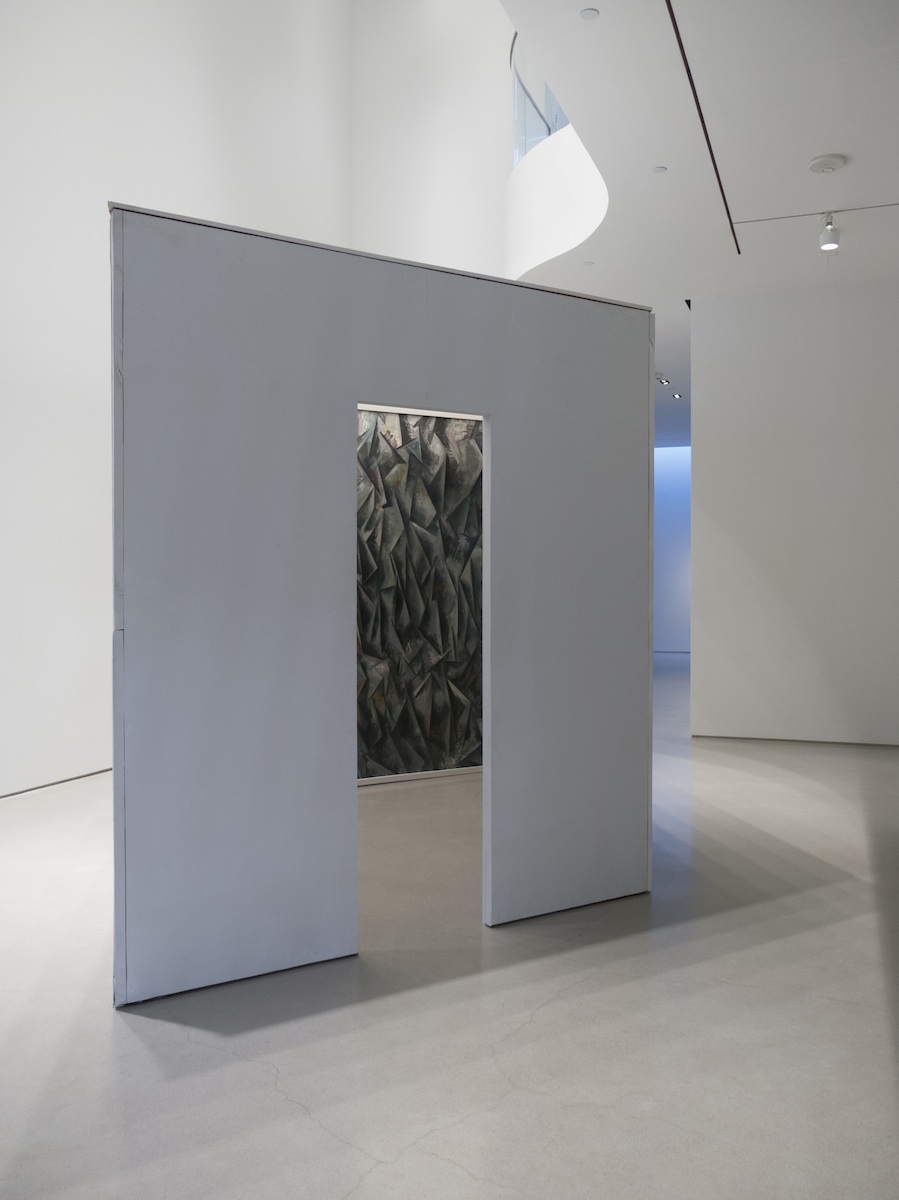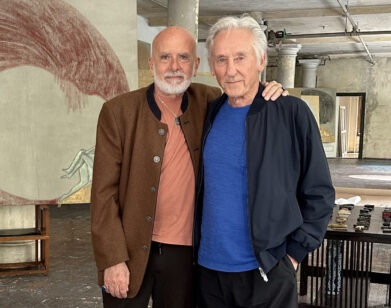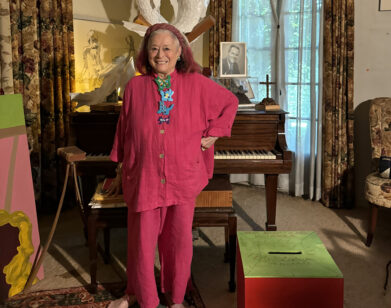Guillermo Kuitca Knows the Way
Historically, much of Guillermo Kuitca’s art has relied on bird’s-eye perspective rendered in two dimensions: floor plans, theaters, and maps have inspired major series over the last three decades. So it didn’t seem strange when, days before opening at downtown’s Sperone Westwater Gallery, the artist was agonizing about how to install the show’s centerpiece, a three-dimensional room at an up-close human scale.
The untitled work resembles a hut-like white cube with a single doorless entrance. A sheet of jagged angles, resembling Cubo-Futurist patterns, shudders across the inside surface. Its precedent is a mural enveloping a room in Somerset, England, painted in June 2013.
The four-panel unit at Sperone Westwater is Kuitca’s first freestanding piece. “It’s meant to have a roof,” he frowns. “But I’m not sure now whether to add one.” A roof would seal the room, making it intimate. Viewers would become a “part of the painting.” Without a roof the work, in the lobby, could be viewed from the gallery’s second floor balcony–effectively a bird’s-eye view relating to his earlier practice.
Yet as he talks about the cube, it’s clear that Kuitca yearns to pull viewers in, rather than to expel them to aerial heights. “Immersion” is the word he repeats. The work’s rectangular doorway gapes enigmatically in a few canvases, an overarching metaphor for absorption and transition. In one painting, it manifests as a grey void cautiously approached by a woman (Kuitca’s first figure since early in his career). He hints that he identifies with her, as he enters a new artistic phase. On the second floor three canvases advance his past focus on maps: three ficticious lands are delineated. Of these, one is made of colored paper bits, sprinkled with numbers and illegible words. But nothing points to a definitive place. The exhibition’s name, “This Way,” suggests a gentle guiding voice rather than a dictatorial artistic authority.
Born in 1961, Kuitca began painting as a child in Buenos Aires, Argentina, where he is still based. Early recognition led to steadily rising fame, and Kuitca’s had solo shows at the Museum of Modern Art, Paris’s Fondation Cartier, and a 2003 retrospective at Madrid’s Reina Sofia. A major 2009 survey was shown at Washington DC’s Hirshhorn Museum, Minneapolis’s Walker Art Center, and the Miami Art Musuem. This is his ninth solo show with Sperone Westwater, his New York gallery since the early 1990s.
The artist walks us through the works one by one, before they are installed. We see the final show later that week: Over the white cube is an opaque veil, not quite a roof, thin enough to let light in.
GUILLERMO KUITCA: I wanted to take a traditional idea: getting immersed in the work. Literally, you enter the painting. The shapes are very modernistic. They are echoes of futurism and also modernist styles. But I try to use a sort of language that I’ve been using lately in my paintings and it seems like a right way to feel the space. A very interesting thing happened: [pointing at a photograph of the work’s interior] There is a corner here. The shapes are so angular that the space completely…
RACHEL SMALL: …dissolves it…
KUITCA: …dissolves it. You have almost no indication that what we’re looking at is a three-dimensional space.
[Speaking about the map-collage canvas, Untitled (2013)]
KUITCA: This is a fractionary and fragmentary map. I used to do maps in the ’90s, maps that looked more like maps. But then somehow I didn’t have any interest in the fact that names were readable or recognizable. Somehow it was enough for me to have a number, or a little fragment of the road.They could be pretty much any place.
SMALL: I feel like I keep trying to recognize it.
KUITCA: There’s no real hints. [gesturing at a gibberish word in the work] There is a mysterious word here, which, sometimes I think is “monster,” because it reads vaguely like that. Every time I was somehow composing something that started to be readable, I would make an effort to make it unreadable. Except for the numbers.
SMALL: Why?
KUITCA: The numbers don’t have a geopolitical reference. So, it’s impossible to know if that number is in German or Spanish or in Japanese. It’s pretty much common ground; numbers are global information.
SMALL: The map could be of anywhere.
KUITCA: In a way. I was trying to get an image that is creating itself. Sometimes when I look at this work, it looks like it’s exploding, but maybe in the opposite way. Eventually, this will end up being one piece of the world, one part. I have the idea that maps were meant to get lost and not make us orientated—and I think this is pretty much that.
SMALL: You’ve been doing maps for a while; can I ask why you became interested in maps in the first place?
KUITCA: The first time I did maps was in the late ’80s. It was a moment when my painting had been before very figurative and theatrical. Theater was sort of a reference in my work. I wanted to find a material that was not necessarily an abstraction but not necessarily a figure. So I tried to use a fine line that was in the cartography, in the architecture, something with plans—something that is referential but not figurative. It was interesting to portray a human condition but not human figures. I found that there were so many artists, like Vermeer, that had worked with maps. But I approached it with an air of innocence. Like I found the map, and I was like, “Wow, this is something wonderful. I have to do something with this.”
SMALL: The human impulse to make maps is also interesting: we want to understand and control our environment, so we map it all out.
KUITCA: Also geopolitcal lines. Their maps, it’s almost like palm reading, you know? Someone will tell your future by looking at the map. [laughs] I thought it was a little bit like that. In the beginning, I didn’t transform the maps too much. It was a transcription of maps into my paintings.
SMALL: How much of the map is planned out, and how much of if is a spontaneous decision?
KUITCA: It’s still spontaneous even if it’s planned out.
SMALL: Yeah. [laughs]
KUITCA: I would actually use the word, “intuitive.” There are moments where, for instance there are incomplete areas and it’s just a simple act of thinking, “Oh, that looks good like this,” or “That, I want to leave it undone.” But those moments are part of the process.
SMALL: You mentioned you felt like in this canvas [Untitled, 2014, in the first floor gallery, with a dark figure and pink backdrop], you identify with the female figure. Can I ask what you mean by that?
KUITCA: I’m talking about those particular works, about these constructions and these shapes. For a painter who all his life spent painting in two dimensions, going to three dimensions, it’s a transformation. You spend all your life trying to understand the world you inhabit in two dimensions, and suddenly, you find another one. It’s almost like a completely unknown territory for me. I found that the two-dimensional work that I was inhabiting was pretty wide and pretty challenging too. So it’s not like I was too comfortable. Maybe that uncertainty is more personal. But this is personal enough in a way.
SMALL: How do you think people will react to the show? Especially the cube?
KUITCA: You never know what people will think of your work. Sometimes they don’t react at all. When they do, it’s such a private and maybe such a small and very intimate connection with the work that I don’t even have any feedback of that. I think that as a visual artist, you learn to inhabit a world in which the relationship between your work and the audience is just is happening between them.
If a viewer has been moved, or made a connection, it will be a very quiet thing. I think that this work [the cube] is more about the immersion—how it feels to be a part of a painting. How it feels if you are inside a work. I’m not so sure if I can achieve that physically because obviously we have a body, we are part of an outside world. Only maybe with drugs, you could create some sort of a vacuum where, you know, there’s no body, there’s no ground, there’s no roof, there’s no gallery, there’s no artwork. [laughs] When there is a city, a street, a gallery, a door, then you are encapsulated in something that looks more like an immersion into a pictorial world. I really would like that people would feel that.
SMALL: You can get lost in it, which I feel is a wonderful thing for art to achieve.
KUITCA: That would be really good for once. I don’t think this work comments on certain modernist styles, like cubism or futurism. [With those movements], what was born was the idea of the artist [departing] from the canvas. Going back to that moment with these three-dimensional spaces is a way to put certain things in perspective. It’s been long enough now. Those modernist paintings are probably a hundred years old.
SMALL: It’s funny that they’re still called modernist.
KUITCA: History takes words and then they are so resistant [to change]. It’s very hard to dismantle or to undo what history does.
SMALL: Then again, why would you want to? For the sake of logic?
KUITCA: That’s a good point. I like logic, though.
SMALL: It’s comforting. It makes everything fit together.
KUITCA: It is comforting, but only when you understand it. When you don’t understand it, it’s really unsettling. Maybe I like logic as a study, but you know, as a painter, you inhabit such a subjective world. Sometimes every hint of precision looks like diamonds to me.
SMALL: Do you fight for that precision?
KUITCA: I don’t [laughs]. I have to believe in what I do, that’s why. I have to believe that that is true. But that’s all I have. No more proof than that, so.
SMALL: Yeah. How do you know when something is finished?
KUITCA: It’s very intuitive. I don’t start most of my work with studies. So if I stop, I just stop. It’s a very dangerous thing to stop too late.
SMALL: What’s the strongest reaction you’d like a viewer to have?
KUITCA: That encounter, that immersion moment. It would be pretty happy; it doesn’t have to be dark. Maybe it will be intense but it doesn’t have to be a dark experience. It can be a joyful one. Maybe if you go through that door with the lady in the painting, that will be a little bit darker. So, we can’t promise any happy thoughts. But for the rest, the things I expect are related to this immersion. I know I’ve use this word too many times but I can’t think of a better word. In a way, immersion is trying to understand someone else. So, who knows? Maybe this world is a mind. Maybe this room [the white cube] is after all the shape of my mind. [laughs] I hope I’m not that square!
“THIS WAY” IS ON DISPLAY AT SPERONE WESTWATER GALLERY THROUGH JUNE 21.







